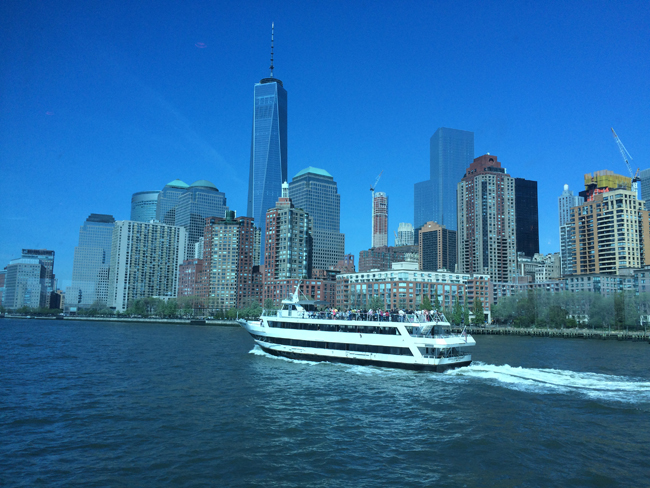
Photo: Paul C. Focazio / NYSG
New York City, NY, May 12, 2016 - New York's metropolitan region is surrounded by water - oceans, bays, rivers, creeks and estuaries. Bringing the issues facing the area's various waterfronts is The Waterfront Alliance (TWA), a coalition of more than 900 organizations (including New York Sea Grant) working together to bring about real change to our region’s 700 miles of shoreline.
"We are a unified voice for our shared waterfront," says Waterfront Alliance's President and CEO Roland Lewis of the coalition's hundreds of businesses and nonprofit organizations throughout New York, New Jersey, Connecticut and beyond. "Our partners are helping to build consensus on important waterfront policy and planning issues by coming together for events like our annual City of Water Day and Waterfront Conference."
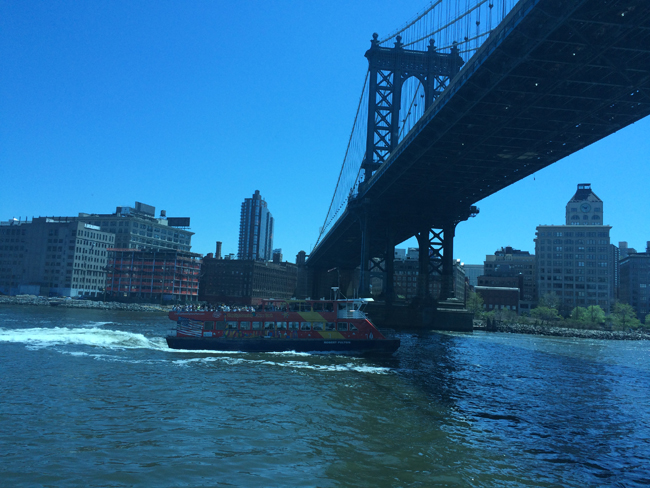
Photo: Paul C. Focazio / NYSG
Today, The Alliance is holding its annual conference aboard the Hornblower Infinity at Hudson River Park Pier 40 in Greenwich Village. As it has in previous years, the conference provides a platform for participants to debate the future of our region's waterfronts, tackling the challenges to defining and delivering equitable access to jobs, education, transportation and recreation at the water's edge.
With its theme of "Defining and Delivering Equity at the Waterfront," this year's event evokes a number of questions: How can the public deepen its sens of ownership over local waterfronts and what tools can public officials use to reach new voices? How can extending the reach lead to a diverse, comprehensive vision for the future of the waterfront that balances local, regional and global needs?
In an effort to explore every angle of defining and delivering equity at the waterfront — from financing and management of public waterfronts to bringing urban youth to the water and everything in between — there's a keynote conversation, eight sessions, and special field workshop.
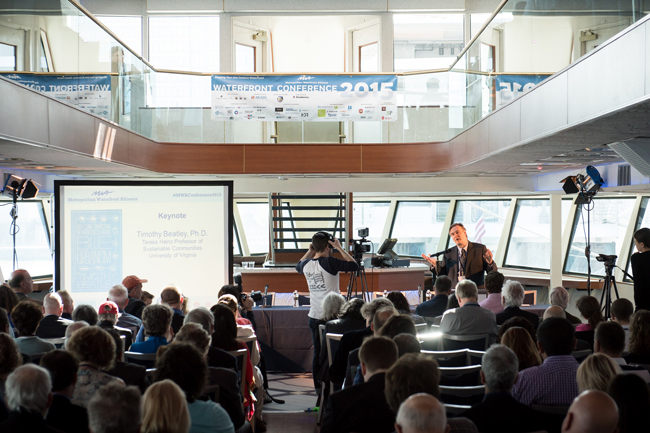
2015 Conference Keynote Speaker Tim Beatley, Ph. D., author, Blue Urbanism: Exploring Connections between Cities & Oceans; Teresa Heinz Professor of Sustainable Communities, School of Architecture, University of Virginia. Photo: Ian Douglas / TWA. More photos from the event via TWA's Flickr page.
The Alliance's annual Waterfront Conference has grown into the premier forum for dialogue and discourse about the New York Metro area's shared waterfront. The event draws more than 600 participants, including policymakers, waterfront advocates, journalists, academics, as well as engineering, architecture, and nonprofit professionals. Each conference focuses on a different theme, with common threads including the working waterfront, waterfront access, climate change, resiliency, and governance.
More video clips from TWA via its YouTube channel, which includes a video playlist from the Alliance's 2015 Conference.
Last year's event, which is highlighted in the six-and-a-half-minute video above, zeroed in on topic of "Shaping Your 21st Century Waterfront."
"We were overjoyed by the standing-room only participation at that event and so we are pleased to maintain our commitment as the primary sponsor for this year's conference," said Peter Glus, city executive in New York City for ARCADIS, an international engineering and design firm. "The presentations and breakout sessions at these conferences are instrumental in bringing the city's best minds together and understanding the complexities of building a sustainable New York City with a resilient coastline, harbor, and waterfront."
At last year's event, the then-named Metropolitan Waterfront Alliance announced that by summer 2015 it would become known as "The Waterfront Alliance," a time when it would also roll out its new branding, including a refreshed Web site and design for its e-newsletter, WaterWire. During the conference's welcoming remarks, board chairman Chris Ward announced the news, and President and CEO Roland Lewis and board members offered a peek at the organization's new logo. This and other moments from the day were documented via Twitter. Those tweets are displayed in some collages compiled by New York Sea Grant's Web Content Manager Paul C. Focazio, who was in attendance.
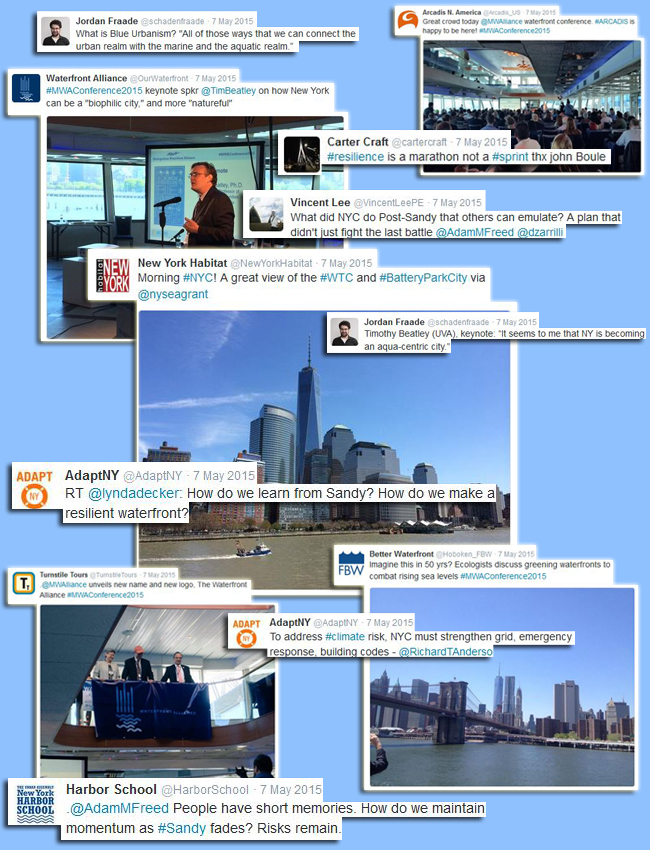
In October 2012, Hurricane/Superstorm Sandy forced us to reconsider how we view the many billions of gallons of water that surround us in this city of islands. For it's part, New York Sea Grant has an archive of its discussions on the topic at www.nyseagrant.org/superstormsandy. Our organization also offers Hurricane Education resources at www.nyseagrant.org/hurricane and information on its 18-month-long $1.8M National Oceanic and Atmospheric Administration-funded social science projects known as the Coastal Storm Awareness Program at www.nyseagrant.org/csap.
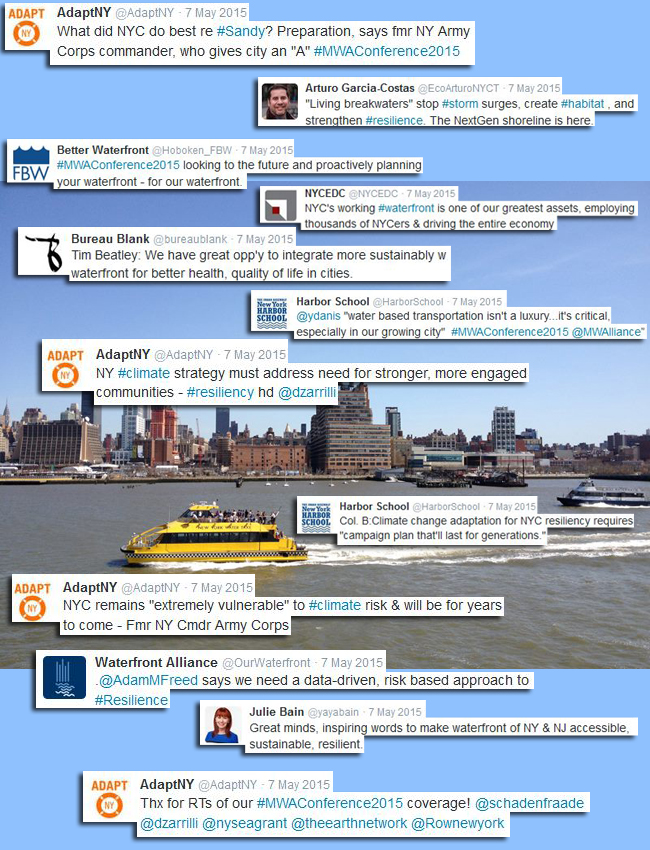
Just one hurricane season short of Sandy’s three-year anniversary, the prevailing mood on board TWA's 2015 Waterfront Conference was not so much regret for past mistakes, but excitement about future opportunities, not only regarding storm preparation, but also building by the waterfront, restoring maritime industry, and getting around by water.
"New York is becoming an aquacentric city,” said Timothy Beatley, professor of sustainable communities at the University of Virginia and the conference’s keynote speaker. We are at our happiest and healthiest when among nature, he believes, and as we live in cities more and more, we need to restore the natural environment to our everyday lives. The urban experience is not and cannot necessarily be an unnatural experience. It sounds obvious post-Sandy, but the more we learn to live with the water, the less disastrous the next big storm will be. And hopefully, in the mean time, we’ll begin to see that previously scary, dirty, dark expanse as a fabulous place to swim in, sail over, wade through, breathe in and gaze upon.
More Info: New York Sea Grant
New York Sea Grant (NYSG), a cooperative program of Cornell University
and the State University of New York, is one of 33 university-based
programs under the National Sea Grant College Program (NSGCP) of the
National Oceanic and Atmospheric Administration (NOAA). The NSGCP
engages this network of the nation’s top universities in conducting
scientific research, education, training and extension projects designed
to foster science-based decisions about the use and conservation of our
aquatic resources. Through its statewide network of integrated
services, NYSG has been promoting coastal vitality, environmental
sustainability, and citizen awareness about the State’s marine and Great
Lakes resources since 1971.
New York Sea Grant maintains Great Lakes offices at SUNY Buffalo, the
Wayne County Cooperative Extension office in Newark and at SUNY Oswego.
In the State's marine waters, NYSG has offices at Stony Brook University
and Stony Brook Manhattan, in the Hudson Valley through Cooperative
Extension in Kingston and at Brooklyn College.
For updates on Sea Grant activities: www.nyseagrant.org has RSS, Facebook, Twitter, and YouTube links. NYSG also offers a free e-list sign up via www.nyseagrant.org/coastlines for its flagship publication, NY Coastlines/Currents, which is published several times a year.